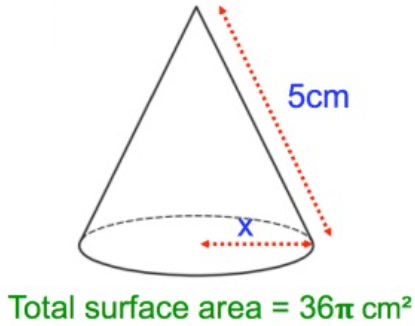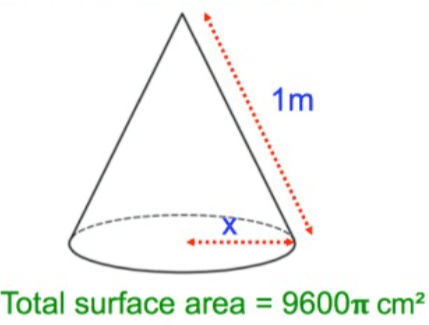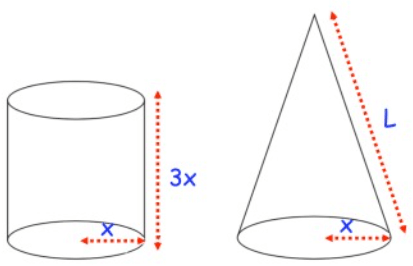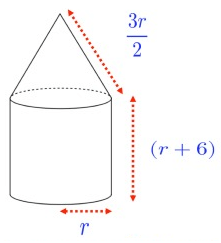FIND RADIUS OF CONE WHEN GIVEN SURFACE AREA
To find lateral surface area and total surface area of cone, we use the formulas given below.
Lateral surface area = πrl
Total surface area = πrl + πr2
= πr(l + r)
Here r = radius, l = slant height
Find length of radius of the following cones given below.
Problem 1 :

Solution :
Total surface area = πr(l + r)
πr(l + r) = 36π
radius(r) = x and slant height (l) = 5 cm
xπ(5 + x) = 36π
5x + x2 = 36
x2 + 5x - 36 = 0
(x + 9) (x - 4) = 0
x = -9 and x = 4
So, the required radius is 4 cm.
Problem 2 :

Solution :
Total surface area = πr(l + r)
πr(l + r) = 9600π
radius(r) = x and slant height (l) = 1 m = 100 cm
xπ(100 + x) = 9600π
100x + x2 = 9600
x2 + 100x - 9600 = 0
(x + 160)(x - 60) = 0
x = -160 and x = 60
So, the radius is 60 cm.
Problem 3 :
The cylinder and cone has the same surface area. Express L in terms of x.

Solution :
Surface area of cylinder = 2πr(h + r)
Surface area of cone = πr(l + r)
height of cylinder = 3x and slant height of cone = l
2πx(3x + x) = πx(l + x)
2x(4x) = x(l + x)
8x2 = lx + x2
Subtracting x2 on both sides.
7x2 = lx
l = 7x
Problem 4 :
A cone and cylinder are joined to make a solid

Find the total surface area of the solid.
Solution :
Total surface area of the figure given above =
lateral surface area of cylinder + lateral surface area of cone
= 2πrh + πrl
= πr(2h + l)
= πr(2(r+6) + (3r/2))
= πr(2r + 12 + (3r/2))
= πr((4r + 24 + 3r)/2)
= πr((7r + 24)/2)
Recent Articles
-
Finding Range of Values Inequality Problems
May 21, 24 08:51 PM
Finding Range of Values Inequality Problems -
Solving Two Step Inequality Word Problems
May 21, 24 08:51 AM
Solving Two Step Inequality Word Problems -
Exponential Function Context and Data Modeling
May 20, 24 10:45 PM
Exponential Function Context and Data Modeling